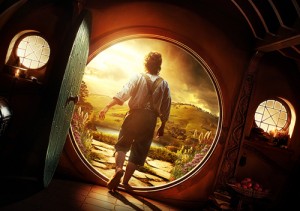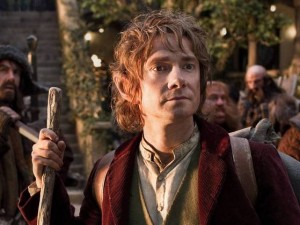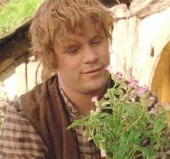(Update #2: I saw this again in IMAX 3D and did not enjoy it nearly as much. I’m so glad I saw this in 2D first because if I’d initially seen it in 3D I think I would have really been depressed. The tinted 3D glasses made everything seem dreary and dingy–even the stuff shot in the Shire. My eight-year-old son, however, LOVED it in 3D!)
(Update #1: Really disparate reactions to this blog and the film in general. People seem to either love The Hobbit: An Unexpected Journey, or they feel terribly disappointed. Some have even told me they think Peter Jackson has eviscerated their beloved book. Maybe you have to go into the theater expecting to hate it like I did? I keep remembering little things like the thrush cracking the snail. Anybody who has read The Hobbit will know the significance this scene has for the next film in the trilogy. It’s that kind of subtle detail that makes seeing this movie such a wonderful cinematic experience.)
I saw the movie today in the old school style—2D and 24 FPS. From the opening shot I felt like I was back in that brilliantly realized cinematic world of Middle-earth that so many of us fell in love with almost a dozen years ago. The colors, the feel, the music. It’s all the same as the first trilogy when you experience it at 24 frames per second. But I didn’t really discern the full force of the Wingnut Films movie/storytelling magic in this movie until that shot of Smaug’s fat Dragon tail snaking and flicking as it disappeared through the Gates of Erebor. I started laughing out loud. Not because I thought it was ridiculous. The total opposite. It was because it seemed so real. The little bits we saw of Smaug before this shot showed him to be a badass of monumental proportions (way scarier than the inane monsters in the preview for Pacific Rim that preceded the showing). Smaug’s tail whipping back and forth lazily, like a cat’s tail, as the Dragon sauntered into his new digs…it was just a beautiful and subtle bit of filmmaking.
Surprisingly, this is one of the funniest movies I’ve seen in a long time. I found myself laughing out loud every couple of minutes during the first part of the film. Martin Freeman has created a character that will become a classic in film history. He is Bilbo Baggins. And I’ll even go so far as to say (and go ahead and crucify me Tolkien purists) that his Bilbo is a way more interesting protagonist than Tolkien created in his book. From Bilbo’s “Good morning” bit with Gandalf, to his interactions with the Dwarves, to his Riddles In The Dark scene with Gollum (a scene that feels like you’re watching two pro-actors in the most awesome black box theatre production of The Hobbit ever staged!), Freeman manages something most actors never accomplish: he lets us see inside his head—see his thoughts—without resorting to pulling a bunch of stupid faces. He’s incredibly subtle in this story of mercy and friendship masquerading as an action-adventure flick. The guy just blew me away. The little vocal hitch he does in his line “I’m a Baggins…(errp) of Bag End” was so perfect. One of those wee miracles of acting that I’m certain he came up with on his own during takes. My god! This guy can even act with his back to the camera! When he wakes up the morning after the Dwarf-party and he’s all alone in his Hobbit-hole, staring down the hall toward the front door facing away from us, you can feel him thinking “Oh crap, what have I done? I need to go on this adventure!” And after he catches up with the Dwarves and realizes he doesn’t have his handkerchiefs and tries to make them all go back to Bag End to get them…so perfect. In the book he merely mentions he’s forgotten them. But in the movie he’s like, “Stop! We have to go back!” Ludicrously pompous. Totally Bilbo.
The Hobbit is a luxurious and beautiful film: the sparks floating out of the chimney at Bag End like magical fireflies, the overhead of Hobbiton as Bilbo races through yards and gardens to catch up with the Dwarves, the pine trees burning on the cliff’s edge…and that last shot of the heaps of gold in Erebor with Smaug shaking himself awake, then revealing his evil cat-like eye (which is basically how I predicted the movie would end in a blog I wrote over three months ago). And what about that scene where Thorin is striding off the felled pine tree, marching into the burning brush toward Azog? It was like a scene from the greatest opera ever staged! (Don’t you wish you could see an opera with Richard Armitage, Orcs and a Dragon? Hell, I’d go.) Should I mention the flight of the Eagles? We’ve seen this before, right? Gandalf’s rescue in The Fellowship of the Ring and Sam and Frodo lifted from the fires of Mount Doom at the end of The Return of the King. But it was way more awesome here. Spectacular. Crazy-ass-fantasy beautiful. That scene where they landed on The Carrock was perfect. And them all gazing across the Wilderlands toward Mount Doom far in the distance. I can’t wait for the next one!
By the way, I know there’s some stupid shit in this movie. Radagast’s bunny sled is simply asinine. But I didn’t care. And there were too many damned scenes with Dwarves and Bilbo on shifting ledges and Dwarves and Gandalf on shifting jerry-rigged goblin gangways and Dwarves and Bilbo and Gandalf on shifting pine trees. Enough with the 3D crap. It doesn’t need it. But still…I didn’t care.
I haven’t had this much fun at a move since…well…since my wife and I got the director’s cut for The Return of the King. And that’s what was so special about The Hobbit: An Unexpected Journey. It felt like we were treated to the director’s cut in the theater. I loved hearing the two-minute-long ode to Erebor! I loved the fact we got to see that cool flashback to the Dwarf/Orc battle! (The Battle of Azanulbizar–thanks for this factoid, Tolkien Britta!) I was amazed at how long the scene with the trolls went on. I relished every second of it. And when Gandalf appears and cracks that massive rock with his staff—splits in twain—to conveniently let the rising sun shine forth, thus turning the trolls to stone, I gasped with surprise! That’s movie magic. The writers took a scene from the book and added a clever little twist. “What if the sun were behind the rock. It’s going to be another ten minutes until it’s high enough to shine on the trolls. What would Gandalf do?” Answer: “He’d split the friggin’ rock right down the middle.” Praise to the screenwriters for this cool idea!
I have to say something about the actors. Richard Armitage turns what could have been a stuffy asshole of a character into someone deep and troubled and full of yearning. And James Nesbitt, in what might have been a throwaway roll as the Dwarf-in-the-dorky-hat, turns the raunchily-named Bofur into a sweet yet wicked guy developing a budding friendship with Bilbo. Both Armitage and Nesbitt are rangy men—both over six feet tall. It’s a testament to the skill the filmmakers have achieved with scaling the actors that they appear squat and realistically Dwarfy (yeah, I know that’s not a word) next to Gandalf and the Elves.
I have to praise Andy Serkis for creating the most stunningly realized mo-cap character in the history of film. He should win an Academy Award for best supporting actor even though he’s only on screen for about twenty minutes in this movie. When he falls over after losing the riddle contest—just collapses on his side like a worn out toddler…brilliant! That’s not special effects. That’s acting, dammit!
Oh, and Ian McKellen? He is “Ass-Kicker The Grey” in this movie. Wonderful acting aside, he just plain kicks Orc-arse. The part where he launches the blue bomb in the Goblin King’s Cave was a better weapon than anything I’ve ever seen in a video game. And then he does some serious Orc-smiting. I also loved how they have him be this sort of sheepish guy when he’s sitting across from Saruman at the White Council meeting. It’s like the writers and Peter Jackson said “Gandalf is kind of an f-up at this stage in his life. He’s the Istari who’s always getting into trouble with grumpy Saruman who admonished him for his harebrained schemes.” Gandalf is like Harry Potter trying to get the Ministry of Magic to believe Voldemort is back. It’s hilarious. “Sauron is really coming back!” “Oh, come on Gandalf, he’s dead.” “I dunno, Saruman. We should go to Dol Guldur…Morgul blade…bad feeling…” (I also liked the way Galadriel is already suspicious of Saruman here and speaks to Gandalf one-on-one with her Elven mind-meld.)
Why are critics, for the most part, ripping this film apart? I don’t get it. The production design is stupendous (John Howe and Alan Lee–you guys are masters). I was enthralled. I laughed heartily, I got numerous chills, and I left the theater with a big smile on my face. Maybe the whole 48 FPS thing really is distracting. I don’t know. But I got to go to Middle-earth again, and it was my best trip yet.



